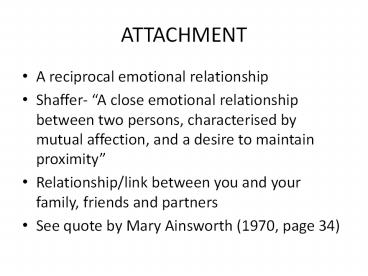ATTACHMENT - PowerPoint PPT Presentation
1 / 12
Title:
ATTACHMENT
Description:
ATTACHMENT A reciprocal emotional relationship Shaffer- A close emotional relationship between two persons, characterised by mutual affection, and a desire to ... – PowerPoint PPT presentation
Number of Views:128
Avg rating:3.0/5.0
Title: ATTACHMENT
1
ATTACHMENT
- A reciprocal emotional relationship
- Shaffer- A close emotional relationship between
two persons, characterised by mutual affection,
and a desire to maintain proximity - Relationship/link between you and your family,
friends and partners - See quote by Mary Ainsworth (1970, page 34)
2
BENEFITS CONSEQUENCES
- Food and care
- Protection
- Education in survival
- Shapes long-term relationships
- Security may affect romantic relationships
- Friendship
- Relationship with own children
3
Evaluation
- OTHER EXPERINCES
- This could affect future relationships e.g.
divorce of parents , moving home/school
frequently. Adult experiences within the
relationship.
- INDIVIDUAL DIFFERENCES
- Temperament rather than experience may affect our
relationships, a difficult infant may result in
poor attachment and then poor relationships
4
What are the theories of attachment?
- Learning theory
- A group of explanations (classical and operant)
which explain behaviour in terms of learning or
learnt behaviour (or nurture) - Classical conditioning
- Operant conditioning
- Evolutionary theory
- Explains that behaviour is innate or natural and
due to evolution - Innate
- Sensitive period
- Social releasers
- Monotropy
- Internal working model
- Continuity hypothesis
5
Learning theory
- All behaviour (including attachment) is learnt
rather than inborn - Children are born as blank slates
- What children become is due to their life
experiences - Behaviourists put these theories forward
- Behaviour is learned by classical or operant
conditioning
6
Classical conditioning.....
- Learning by association, i.e. making links with
an experience - Ivan Pavlov, research on the salivation of dogs
- Each time dogs fed salivated
- Dogs started salivating before feeding
- Dogs associated the sound of the door with food
- Dogs learned a new stimulus response (S-R)
7
Explaining classical conditioning...
- Food (UCS unconditioned stimulus) produces a
sense of pleasure (UCR - unconditioned reflex) - During conditioning door opens and food given
at the same time
8
Explaining classical conditioning in babies.....
- Milk is an UCS (unconditioned stimulus) which
naturally provides an UCR (unconditioned reflex)
in the baby of pleasure at relief from hunger.
The reflex response is automatic and it not
learned. - Person who feeds the baby becomes associated with
food a CS (conditioned stimulus) - The feeder produces pleasure that the baby
associates with food. This pleasure is learned or
a CR (conditioned response)
9
Operant conditioning.....
- Learning occurs when we are rewarded for doing
something - Skinners work with cats and rats Skinner boxes
food as a reward - What is the difference between positive
reinforcement and negative reinforcement?
10
Operant conditioning.....
- Positive reinforcement - Each time you do
something and it results in a pleasant
consequence reward - Reward Reinforced behaviour repeated
behaviour reward - Negative reinforcement when a behaviour
switches off something unpleasant, will be
repeated, e.g. Baby crying caregiver cuddles
11
Operant conditioning.....
- Behaviour that result in an unpleasant
consequence punishment - Punishment behaviour not repeated
12
Explaining operant conditioning in babies.....
- Dollard and Miller (1950)
- Hungary baby feels discomfort crying
caregiver aims to reduce discomfort feeds - Baby is fed reduces discomfort stops crying
- Food primary reinforcer because it reinforces
the behaviour (crying) reduces discomfort - The person who reduces discomfort secondary
reinforcer - Attachment (or bond) occurs when the baby seeks a
person to provide food person reciprocates































